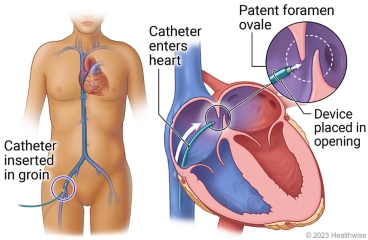Patent Foramen Ovale (PFO) Closure: Before Your Procedure

What is a patent foramen ovale closure?
The foramen ovale (say "fuh-RAY-men oh-VAL-ee") is an opening in the heart's septum. This is the part that separates the upper right and left chambers (atria) of the heart. The foramen ovale normally closes after birth. But sometimes it stays open. This is called a patent (say "PAY-tunt") foramen ovale, or PFO. A PFO usually doesn't cause problems as the person gets older. But sometimes it can lead to problems such as a stroke. This can happen if a blood clot moves out of the heart and travels to the brain.
A PFO closure is a procedure that can help lower the risk of a stroke for some people. A device is used to close the opening so that blood and blood clots don't flow through the opening anymore. A thin, flexible tube called a catheter will be used to place the device in your heart.
You may be asleep for the procedure, or you may get a sedative to help you relax. Your doctor makes a small cut in your groin. Then the catheter, with tools inside it, is put into your blood vessel and carefully guided to your heart. Your doctor moves the tip of the catheter to place a small device inside the PFO. The device expands and closes off the opening. It stays inside your heart. The catheter is then removed. In time, your heart will heal around the device. A layer of heart tissue will help seal off the PFO.
You may spend the night in the hospital, or you may go home the same day.
How do you prepare for the procedure?
 Preparing for the procedure
Preparing for the procedure
- Be sure you have someone to take you home. Anesthesia and pain medicine will make it unsafe for you to drive or get home on your own.
- Understand exactly what procedure is planned, along with the risks, benefits, and other options.
- Tell your doctor ALL the medicines and natural health products you take. Some may increase the risk of problems during your procedure. Your doctor will tell you if you should stop taking any of them before the procedure and how soon to do it.
- If you take a medicine that prevents blood clots, your doctor may tell you to stop taking it before your procedure. Or your doctor may tell you to keep taking it. (These medicines include aspirin and other blood thinners.) Make sure that you understand exactly what your doctor wants you to do.
- Make sure your doctor and the hospital have a copy of your advance care plan. If you don't have one, you may want to prepare one. It lets others know your health care wishes. It's a good thing to have before any type of surgery or procedure.
What happens on the day of the procedure?
- Follow the instructions exactly about when to stop eating and drinking. If you don't, your procedure may be cancelled. If your doctor told you to take your medicines on the day of the procedure, take them with only a sip of water.
- Follow your doctor's instructions about when to bathe or shower before your procedure. Do not apply lotions, perfumes, deodorants, or nail polish.
- Do not shave the surgical site yourself.
- Take off all jewellery and piercings. And take out contact lenses, if you wear them.
 At the hospital or surgery centre
At the hospital or surgery centre
- Bring a picture ID.
- You will be kept comfortable and safe by your anesthesia provider. The anesthesia may make you sleep. Or you may get medicine that relaxes you or puts you in a light sleep. The area being worked on will be numb.
- The procedure may take about 1 to 2 hours.
After the procedure
- Pressure may be applied to the area where the catheter was put in your blood vessel. This will help prevent bleeding. A small device may also be used to close the blood vessel. You may have a bandage or a compression device on the catheter site.
- Your care team will check your heart rate and blood pressure. They will also check the catheter site for bleeding.
- You will need to lie still and keep your leg straight for up to a few hours.
- You may have a bruise or a small lump where the catheter was put in your blood vessel. This is normal and will go away.
When should you call your doctor?
- You have questions or concerns.
- You don't understand how to prepare for your procedure.
- You become ill before the procedure (such as fever, flu, or a cold).
- You need to reschedule or have changed your mind about having the procedure.
Where can you learn more?
Go to https://www.healthwise.net/patientEd
Enter B398 in the search box to learn more about "Patent Foramen Ovale (PFO) Closure: Before Your Procedure".
Current as of: October 2, 2024
